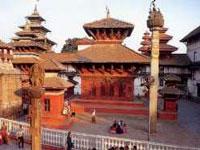 Kathmandu OverviewPresided over by snow-covered mountains, the Kathmandu Valley is
surrounded by verdant agricultural hills scattered with traditional
villages and brick houses, rich in ancient holy temples and shrines
used by both Buddhists and Hindu worshippers reflecting a great
wealth of culture and tradition. Most of Nepal's ethnic groups are
represented in the Valley, particularly in Kathmandu itself, but it
is the Newars who are the original inhabitants responsible for
development and the splendid art and architecture in the
cities. The Valley is the cultural, political and commercial centre of
Nepal and encompasses three cities: Kathmandu the capital; Patan,
which has been enveloped by the growing Kathmandu outskirts; and
the medieval city of Bhaktapur. For the unprepared visitor, the
capital city of Kathmandu can trigger a sensory overload - it is a
heaving city of both intriguing and unpleasant smells, incessant
noise and pollution, and sights that etch themselves on the memory.
Cows wander the streets of the old city, stepping between steaming
piles of rubbish and hooting taxis, and narrow alleyways overflow
with spices, vegetables and handicraft shops. Throngs of people
thread their way along bustling cobblestone streets lined with
structures from an ancient architectural heritage, which lead onto
open squares surrounded by temples of all shapes and sizes. The
largest city in Nepal and the nation's historical centre, Kathmandu
throws together a blend of the country's varied population and
boasts a distinctive, age-old religious influence visible in the
daily life of its inhabitants. Fascinating as this city is however, many people choose to stay
outside Kathmandu in one of the Valley towns or mountain resorts
and restrict their visit to day trips; or they base themselves in
the tourist-orientated Thamel district of the city that offers
modern bakeries, smart hotels and upmarket restaurants, along with
pushy handicraft and cannabis sellers. |